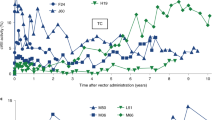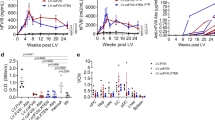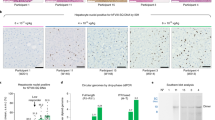Abstract
Hemophilia B is a severe X-linked bleeding diathesis caused by the absence of functional blood coagulation factor IX, and is an excellent candidate for treatment of a genetic disease by gene therapy. Using an adeno-associated viral vector, we demonstrate sustained expression (>17 months) of factor IX in a large-animal model at levels that would have a therapeutic effect in humans (up to 70 ng/ml, adequate to achieve phenotypic correction, in an animal injected with 8.5 × 10 12 vector particles/kg). The five hemophilia B dogs treated showed stable, vector dose-dependent partial correction of the whole blood clotting time and, at higher doses, of the activated partial thromboplastin time. In contrast to other viral gene delivery systems, this minimally invasive procedure, consisting of a series of percutaneous intramuscular injections at a single timepoint, was not associated with local or systemic toxicity. Efficient gene transfer to muscle was shown by immunofluorescence staining and DNA analysis of biopsied tissue. Immune responses against factor IX were either absent or transient. These data provide strong support for the feasibility of the approach for therapy of human subjects.
This is a preview of subscription content, access via your institution
Access options
Subscribe to this journal
Receive 12 print issues and online access
$209.00 per year
only $17.42 per issue
Buy this article
- Purchase on Springer Link
- Instant access to full article PDF
Prices may be subject to local taxes which are calculated during checkout






Similar content being viewed by others
References
Lofqvist, T., Nilsson, I.M., Berntorp, E. & Pettersson, H. Haemophilia prophylaxis in young patients—a long term follow up. J. Int. Med. 241, 395–400 (1997).
Eyster, M.E. et al. Central nervous system bleeding in hemophiliacs. Blood 51, 1179–1188 ( 1978).
Bray, G.L. & Lubahn, N.L. Hemophilia presenting with–intracranial hemorrhage. An approach to the infant with intracranial bleeding and coagulopathy. Am. J. Dis. Children 141, 1215– 1217 (1987).
Lusher, J.M. Prophylaxis in children with hemophilia: Is it the optimal treatment? Thromb. Haemost. 78, 726–729 (1997).
Ragni, M.V., Hord, J.D. & Blatt, J. Central venous catheter infection in hemophiliacs undergoing prophylaxis or immune tolerance with clotting factor concentrate. Haemophilia 3, 90–95 ( 1997).
Kay, M.A. et al. In vivo gene therapy of hemophilia B: Sustained partial correction in factor IX-deficient dogs. Science 262 , 117–119 (1993).
Herzog, R.W. et al. Stable gene transfer and expression of human blood coagulation factor IX after intramuscular injection of recombinant adeno-associated virus. Proc. Nat. Acad. Sci. USA 94, 5804– 5809 (1997).
Xiao, X., Li, J. & Samulski, R.J. Efficient long-term gene transfer into muscle tissue of immunocompetent mice by adeno-associated virus vector. J. Virol. 70, 8098–8108 ( 1996).
Monahan P.E. et al. Direct intramuscular injection with recombinant–AAV vectors results in sustained expression in a dog model of hemophilia. Gene Ther. 5, 40–49 ( 1998).
Fisher, K.J. et al. Recombinant adeno-associated virus for muscle directed gene therapy. Nature Med. 3:306– 312 (1997).
Yao, S.-N., Smith, K.J. & Kurachi, K. Primary myoblast-mediated gene transfer: Persistent expression of human factor IX in mice. Gene Ther. 1 , 99–107 (1994).
Verma, I.M. & Somia, N. Gene therapy - promises, problems and prospects. Nature 389, 239– 242 (1997).
Kay, M.A. et al. In vivo hepatic gene therapy: Complete albeit transient correction of factor IX deficiency in hemophilia B dogs. Proc. Natl. Acad. Sci. USA 91, 2353–2357 (1994).
Fang, B. et al. Lack of persistence of E1– recombinant adenoviral vectors containing a temperature-sensitive E2A mutation in immunocompetent mice and hemophilia B dogs. Gene Ther. 3, 217–222 (1996).
Kohn, D.B. et al. T lymphocytes with a normal ADA gene accumulate after transplantation of transduced autologous umbilical cord blood CD34+ cells in ADA-deficient SCID neonates. Nature Med. 4, 775–780 (1998).
Nienhuis, A.W., McDonagh, K.T. & Bodine, D.M. Gene transfer into hematopoietic stem cells. Cancer 67, 2700–2704 ( 1991).
Matsushita, T. et al. Adeno-associated virus vectors can be efficiently produced without helper virus. Gene Ther. 5, 938– 945 (1998).
Evans, J.P., Brinkhous, K.M., Brayer, G.D., Reisner. H.W. & High, K.A. Canine hemophilia B resulting from a point mutation with unusual consequences. Proc. Natl. Acad. Sci. USA 86, 10095–10099 (1989).
Mitruka, B.M., Rawnsley, H.M. & Vadehra, D.V. in Animals for Medical Research–Models for the Study of Human Disease. 216 (John Wiley & Sons, New York, 1976).
Nakai, H. et al. Adeno-associated viral vector-mediated gene transfer of human blood coagulation factor IX into mouse liver. Blood 91, 4600–4607 (1998).
Baskar, J.F. et al. The enhancer domain of the human cytomegalovirus major immediate-early promoter determines cell type-specific expression in transgenic mice. J. Virol. 70, 3207 (1996).
Kay, M.A. et al. Expression of human alpha1-antitrypsin in dogs after autologous trannsplantation of retroviral transduced hepatocytes. Proc. Natl. Acad. Sci. USA 89, 89–93 (1991).
Svensson, E.C. et al. Long-term erythropoietin expression in rodents and non-human primates following intramuscular injection of a replication-defective adenoviral vector. Hum. Gene Ther. 8, 1797– 1806 (1997).
Yang, Y., Haecker, S.E., Su, Q. & Wilson JM. Immunology of gene therapy with adenoviral vectors in mouse skeletal muscle. Hum. Molec. Genet. 5, 1703–1712 (1996).
Dai. Y. et al. Cellular and humoral responses to adenoviral vectors containing factor IX gene: Tolerization of factor IX and vector antigens allows for long-term expression. Proc. Natl. Acad. Sci. USA 92, 1401–1405 (1995).
Jooss, K., Yang, Y., Fisher, K.J. & Wilson, J.M. Transduction of dentritic cells by DNA viral vectors directs the immune response to transgene products in muscle fibers. J. Virol. 72, 4212–4223 (1998).
Xiao, X., Li, J. & Samulski, R.J. Production of high-titer recombinant adeno-associated virus vectors in the absence of helper adenovirus. J. Virol. 72, 2224–2232 (1998).
Ferrari, F.K., Xiao, X., McCarty, D. & Samulski, R.J. New developments in the generation of Ad-free, high titer rAAV gene therapy vectors. Nature Med. 3, 1295–1297 (1997).
High, K.A. Factor IX: Molecular structure, epitopes, and mutations associated with inhibitor formation. Adv. Exp. Med. Biol. 386, 79– 86 (1995).
Bray, G.L. et al. A Multicenter study of recombinant factor VIII (Recombinate): Safety, efficacy, and inhibitor risk in previously untreated patients with hemophilia A. Blood 83, 2428– 2435 (1994).
Lusher, J.M., Arkin, S., Abildgaard, C.F. & Schwartz. Recombinant factor VIII for the treatment of previously untreated patients with hemophilia A. N. Engl. J. Med. 328, 453–459 ( 1993).
Gilles, J.G.G., Arnout, J., Vermylen, J. & Saint-Remy, J.-M.R. Anti-factor VIII antibodies of hemophiliac patients are frequently directed towards nonfunctional determinants and do not exhibit isotypic restriction. Blood 82, 2452–2461 (1993).
Gilles, J.G., Desqueper, B., Lenk, H., Vermylen, J. & Saint-Remy, J.M. Neutralizing anti-idiotypic antibodies to factor VIII inhibitors after desensitization in patients with hemophilia A. J. Clin. Invest. 97: 1382–1388 (1996).
Miao, C.H. et al. The kinetics of rAAV integration in the liver. Nat. Genet. 19, 13–15 ( 1998).
Duan, D. et al. Circular intermediates of recombinant adeno-associated virus have defined structural characteristics responsible for long-term episomal persistence in muscle tissue. J. Virol. 72, 8568–8577 (1998).
Afione, S.A. et al. In vivo model of adeno-associated virus vector persistence and rescue. J Virol 70, 3235– 3241 (1996).
Evans, J.P., Watzke, H.H., Ware, J.L., Stafford, D.W. & High, K.A. Molecular cloning of a cDNA encoding canine factor IX. Blood 74, 207–212 (1989).
Kessler, P.D. et al. Gene delivery to skeletal muscle results in sustained expression and systemic delivery of a therapeutic protein. Proc. Natl. Acad. Sci. USA 93, 14082–14087 (1996).
Brinkhous K.M., Landen, C.N. & Read, M.S. Evaluation of sensitivity of whole blood clotting time (WBCT), partial thromboplastin time (PTT), and F.IX one-stage bioassay tests with low plasma F.IX levels observed with transfusion or gene therapy in canine hemophilia B. Blood 82, Suppl.1, 592a (1993).
Walter, J., You, Q., Hagstrom, N., Sands, M. & High, K.A. Successful expression of human factor IX following repeat administration of an adenoviral vector in mice. Proc. Natl. Acad. Sci. USA 93, 3056–3061 ( 1996).
Kung, S.-H. et al. Human factor IX corrects the bleeding diathesis of mice with hemophilia B. Blood 91, 784– 790 (1998).
Sambrook, J., Fritsch, E.F. & Maniatis, T. in Molecular Cloning (ed. Nolan, C.) 9.16 –9.19 (Cold Spring Harbor Laboratory Press, Cold Spring Harbor, New York,1989).
Acknowledgements
The authors thank Acuson for supplying the ultrasound equipment, M. Haskins for making the normal dog experiment possible, and J.H. Liu, S.J. Tai, and M.L. McCleland, as well as the Cell Morphology Core of the Institute for Human Gene Therapy at the University of Pennsylvania, for technical assistance. We also acknowledge the work of the staff at the vector production facility at Avigen, and the staff of the Francis Owen Blood Research Laboratory at the University of North Carolina-Chapel Hill. This work was supported by National Institutes of Health Grants R01 HL53668 and P50 HL54500 to K.A.H., and Avigen, a company in which K.A.H. holds equity. P.A.F. is supported by the Katherine Dormandy Trust for Hemophilia, and J.H.H. was supported by NIH grant F32 HL09397
Author information
Authors and Affiliations
Corresponding author
Rights and permissions
About this article
Cite this article
Herzog, R., Yang, E., Couto, L. et al. Long-term correction of canine hemophilia B by gene transfer of blood coagulation factor IX mediated by adeno-associated viral vector. Nat Med 5, 56–63 (1999). https://doi.org/10.1038/4743
Received:
Accepted:
Issue Date:
DOI: https://doi.org/10.1038/4743
This article is cited by
-
Targeted delivery of therapeutic agents to the heart
Nature Reviews Cardiology (2021)
-
Adeno-associated virus gene delivery of broadly neutralizing antibodies as prevention and therapy against HIV-1
Retrovirology (2018)
-
Gene Therapy for Hemophilia: Progress to Date
BioDrugs (2018)
-
Gene therapy for monogenic liver diseases: clinical successes, current challenges and future prospects
Journal of Inherited Metabolic Disease (2017)
-
Promise and problems associated with the use of recombinant AAV for the delivery of anti-HIV antibodies
Molecular Therapy - Methods & Clinical Development (2016)



